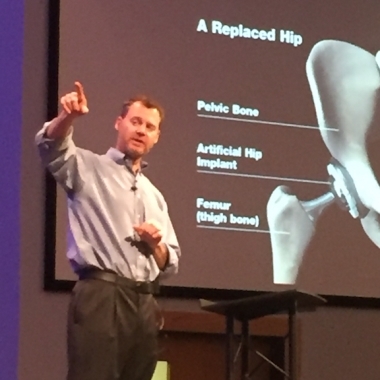Dr. Michael Repine on Hip Arthritis Pain Relief
- Category: Orthopedics, Surgery
- Posted On:
- Written By: Boulder Community Health

Do you experience pain or stiffness on the outside of your hip, over the groin area or in the buttock? Is bending over to put on socks and shoes or getting in and out of the car difficult or even impossible? Then you might be experiencing some of the most common signs of hip osteoarthritis.
Hip osteoarthritis occurs when the cartilage tissue that cushions a hip joint gets worn away.
“Healthy cartilage is slick and creates a smooth surface that helps the bones in the hip joint to roll and slide around easily. Over time, the cartilage grows rough from extensive use and eventually wears down completely, leaving bone rubbing on bone. Hip motion becomes limited, and you feel pain, swelling and stiffness,” orthopedic surgeon Michael Repine, MD, of Boulder Medical Center explained during a free health lecture held on Aug. 27 at the Lionsgate Event Center in Lafayette..
The lifetime risk of developing hip osteoarthritis is about 1 in 5 for men and 1 in 4 for women. It usually develops gradually, over months or years, with many sufferers ignoring the symptoms until their daily activities become affected. Fortunately, there are many approaches for relieving the pain of an arthritic hip, from non-surgical treatments to new surgical options.
Non-surgical treatment options
Dr. Repine said that physical therapy is almost always the first step in treatment with the goal of improving range of motion and strength, as well as reducing the pain.
He went on to describe other non-surgical treatments and the pros and cons of each:
Nonsteroidal anti-inflammatory drugs (NSAIDs)
- Pros: Decreases inflammation and pain.
- Cons: When used long term, there is a risk of gastrointestinal bleeding.
Nutritional supplements
- Pros: Many sufferers find nutritional supplements, such as glucosamine and chondroitin, helpful.
- Cons: Too many of these products don’t measure up to their claims and data on proven effectiveness is somewhat inconsistent.
Cortisone injection
- Pros: Relatively well-tolerated, easy procedure done under fluoroscopy that offers very predictable reduction in pain. It often “buys time” for patients whose joint isn’t quite ready for total replacement.
- Cons: The injection must be placed carefully and can soften the cartilage. Also, it tends to mask symptoms.
Viscosupplement injection (hyaluronic acid)
- Pros: Protects any remaining cartilage and helps improve the biochemical environment of the joint, offering reliable reduction in pain.
- Cons: Currently approved for knees only. Its off-label use in hips is being investigated in clinical studies.
Stem cell therapy
- Pros: When osteoarthritis is caught early, anecdotal reports are promising.
- Cons: It's expensive and uses are still being heavily researched.
Less-invasive surgical technique
If non-surgical treatments don't offer relief, the next step is surgery. When exploring surgery with patients, Dr. Repine said that he looks at many decision variables: the patient's expectations following surgery, the extent of the arthritis, and the patient's age, strength and range of motion.
“The matching and marriage of these decision variables brings us to the surgical option that will maximize the likelihood of a successful outcome,” he said.
Moderate osteoarthritis can often be treated arthroscopically and sometimes with cartilage transplantation. When arthritis becomes advanced, Dr. Repine said that hip replacement is the best option for pain relief and restoring function.
Dr. Repine uses the front-of-the-hip (anterior) approach to hip replacement. Traditional surgery requires cutting through muscles at the back of the hip, leaving patients with a long recovery. With the anterior approach, he accesses the hip joint by making an incision at the front of the hip, near the groin, and gently pushes muscles aside rather than cutting them. This leads to a quicker, less painful recovery.
"One other important benefit of the anterior approach is the very low risk of prosthesis dislocation," he added. “Combining the anterior approach with computer-assisted Mako technology – which uses a state-of-the-art robotic arm and computer-guided mapping software to ensure precise positioning of a hip implant – maximizes outcomes,” said Dr. Repine.
If you suffer from symptoms of hip osteoarthritis, schedule an appointment with Michael Repine, MD, by calling 303-440-3036.
Click here to view PowerPoint slides from Dr. Repine’s lecture on “Latest Treatments for Painful Hips.”
Want to receive notification of special events and lectures? Sign up to receive email notifications.